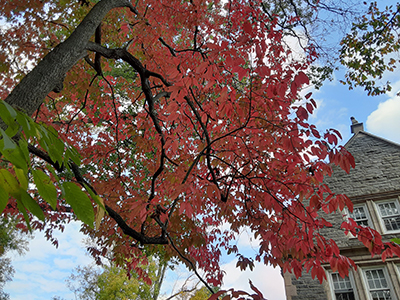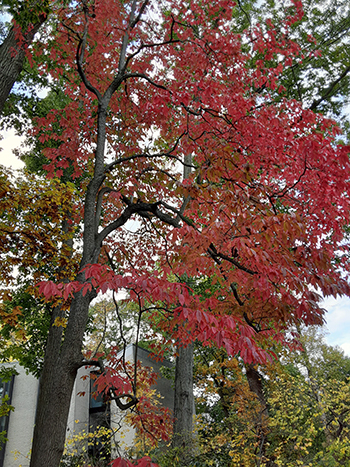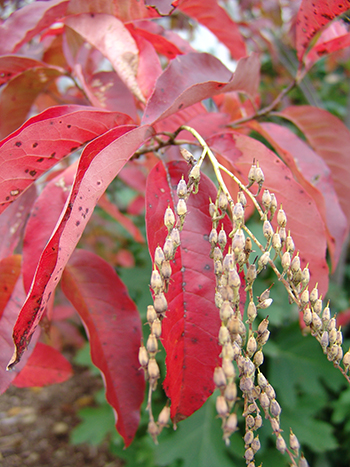
Plant of the Month: Oxydendrum arboreum

Sorrel tree is a wonderful, yet criminally underplanted medium-sized ornamental tree. photo credit: R. Payne-Meyer
Where eccentricity meets grace, behold the sourwood. Oxydendrum arboreum, known commonly as sourwood or sorrel tree is a wonderful, yet criminally underplanted medium-sized ornamental tree. The sole species of the Oxydendrum species, O. arboreum certainly does not lack in uniquity. O. arboreum boasts an interesting growth form, fragrant, bell-shaped flowers, gorgeous fall color, and impressive bark.
O. arboreum is a member of the heath family (Ericaceae), a family composed primarily of shrubs, groundcovers and herbs which thrive in poor, acidic soils. Most commonly found throughout the Southern Appalachians, O. arboreum is native as far North as Western Pennsylvania and as far South as Eastern Louisiana. Though most common in the Southern United States, O. arboreum is quite tolerant of cold temperatures, hardy to zone 4 (-30℉) if sited in a protected location. This tree will often be found growing in oak-heath forests amongst Ericaceous relatives such as Kalmia, Rhododendron, Gaylussacia, and Gaultheria species. O. arboreum trees are tough, but prefer well-drained soil, and will not tolerate heavily alkaline soils, heavy clay, or compacted soils.

O. arboreum typically grows as an understory tree, though mature specimens can become quite large, up to 90’ tall, with the largest recorded reaching 118’! photo credit: R. Payne-Meyer
O. arboreum typically grows as an understory tree, though mature specimens can become quite large, up to 90’ tall, with the largest recorded reaching 118’! Trees tolerate both full sun and part-shade. Cultivated specimens take on an irregular, ovular shape, usually around 30’ tall. Trees I have observed in natural settings are quite inconsistent in their growth form. Vigorous low branches and abrupt angular deviations of the trunk are common sights on these very expressive trees; a crook in the trunk is a familiar feature as plants twist and turn to find light under the canopy of larger trees.
The leaves of O. arboreum have a droopy habit, lending this tree an aesthetic similar to a small, large-leafed weeping willow. The leaves are finely serrated and dark, glossy green. The sour taste of the leaves bestows the common name sourwood. Fall color is consistently remarkable, as leaves progress from scarlet to crimson; this feature is what I find most impressive about this tree.

Flower panicles are suspended from the tips of the branches, often even on the leader. photo credit: R. Maurer
Flower panicles are suspended from the tips of the branches, often even on the leader (the upright stem at the top of the trunk), further adding to the overall pendant appearance of this plant. The sweet-scented flowers hang from panicles, and look very much like lily of the valley (Convallaria) flowers. The panicles are long lasting, showing off into the late fall and contrasting beautifully against the deep red foliage. The panicle stem persists after flowers drop as well, giving the appearance of skeletal fingers, a fascinating item of winter interest. The honey of O. arboreum flowers is highly coveted, adding even more landscape and ecological value to this marevelous native tree.
Also not to be overlooked is the bold bark of O. arboreum. Dark gray, highly fissured bark with broad ridges develops on mature specimens, similar to the alligator hide-type bark of Diospyros or Nyssa spp. The stems of O. arboreum are olive green and red at the tip when young, another pleasing feature standing out from the darker, older bark.
O. arboreum is a great choice as a specimen tree, or in a woodland garden. With a host of aesthetic features offering four season interest, O. arboreum will stand out even when mixed amongst other trees and shrubs. This tree looks great as both an individual or grown in a group; three or five trees makes for a lovely grouping, each of which will likely have a unique growth form. You can find a group of O. arboreum trees growing on the bank behind Willet’s Hall, a singular specimen flanking the side northeast side of Parrish Hall, and a particularly dashing specimen in the wooded section between Wharton Hall and Dana Hall.





Diane Mattis
Posted at 07:46h, 06 NovemberThank you so much for this article. I saw my first Sourwood locally a couple of weeks ago and fell in love with it! Thinking I would love it in my front yard to replace a Red Bud whose main trunk got split in half and damaged badly during the bad wind storm
earlier in the summer. We’ll see….